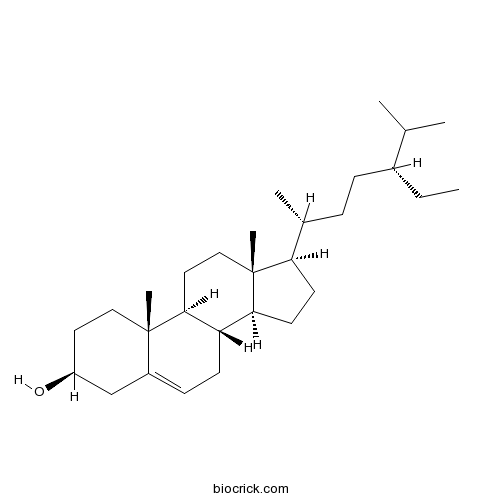A member of the class of phytosterols that is stigmast-5-ene substituted by a β-hydroxy group at position 3.
InChI=1S/C29H50O/c1-7-21(19(2)3)9-8-20(4)25-12-13-26-24-11-10-22-18-23(30)14-16-28(22,5)27(24)15-17-29(25,26)6/h10,19-21,23-27,30H,7-9,11-18H2,1-6H3/t20-,21-,23+,24+,25-,26+,27+,28+,29-/m1/s1
Beta-Sitosterol a main dietary phytosterol found in plants, may have the potential for prevention and therapy for human cancer, β-sitosterol induces apoptosis in HT116 cells is associated with a decreased expression of the anti-apototic Bcl-2 protein and mRNA and a concomitant increase of the pro-apototic Bax protein and mRNA, and with release of cytochrome c from the mitochondria into the cytosol. [1]
Beta-Sitosterol (LD50>3 g/kg i.p. in mice, minimum ulcerogenic dose was 600 mg/kg i.p. in rats)has potent anti-inflammatory activity , similar to hydrocortisone and oxyphenbutazone when administered intraperitoneally; possesses antipyretic activity, similar to acetylsalicylic acid.[2]
Beta-Sitosterol shows a potent angiogenic activity in the chorioallantoic membrane (CAM) assay, it stimulates neovascularization in the mouse Matrigel plug assay and the motility of human umbilical vein endothelial cells in an in vitro wound migration assay in the presence of heparin, thus β-sitosterol is a novel plant-derived angiogenic factor which may have potential pharmaceutical applications for the management of chronic wounds.[3]
Beta-Sitosterol can inhibit proliferation and induce apoptosis in human solid tumors such as colon and breast cancers, it potently induces apoptosis in U937 cells and induces apoptosis is related to the selective activation of caspase-3 and induction of Bax/Bcl-2 ratio.[4]
English website: Beta-Sitosterol
Japanese website: Beta-Sitosterol
Chinese website: Beta-Sitosterol
[1] Choi Y H, Kong K R, Kim Y A, et al. Int J Oncol, 2003, 23(6):1657-62.
[2] Gupta MB, Nath R, et al. Srivastava Planta Medica, 1980, 39(2):157-63
[3] Moon E J, You M L, Lee O H, et al. Angiogenesis, 1999, 3(2):117-123.
[4] Park C, Moon D O, Rhu C H, et al. Biol Pharm Bull, 2007, 30(7):1317-23.
[5] Nair V D, Kanfer I, Hoogmartens J. J Pharmaceut Biomed , 2006, 41(3):731-7.



